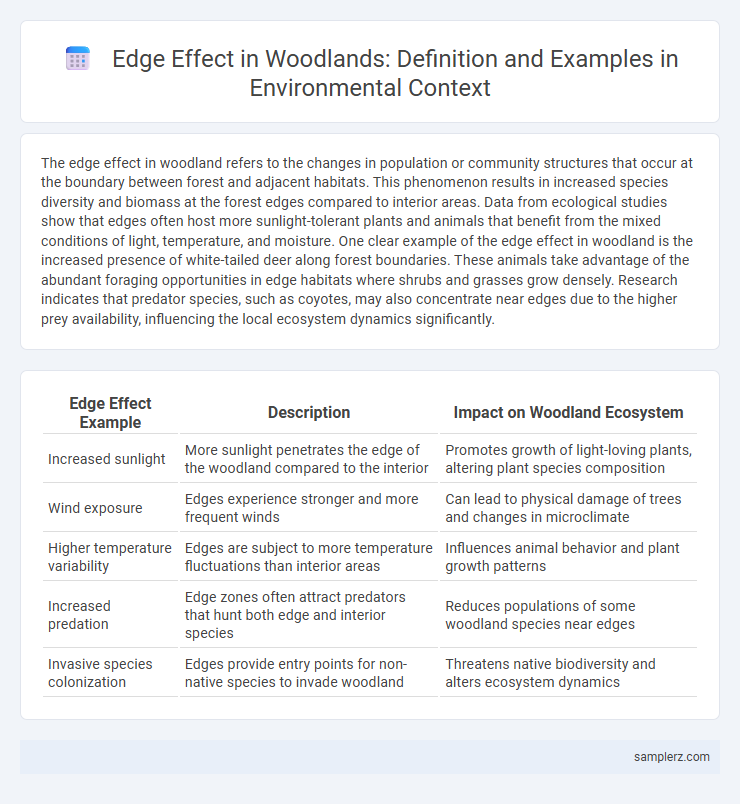The edge effect in woodland refers to the changes in population or community structures that occur at the boundary between forest and adjacent habitats. This phenomenon results in increased species diversity and biomass at the forest edges compared to interior areas. Data from ecological studies show that edges often host more sunlight-tolerant plants and animals that benefit from the mixed conditions of light, temperature, and moisture. One clear example of the edge effect in woodland is the increased presence of white-tailed deer along forest boundaries. These animals take advantage of the abundant foraging opportunities in edge habitats where shrubs and grasses grow densely. Research indicates that predator species, such as coyotes, may also concentrate near edges due to the higher prey availability, influencing the local ecosystem dynamics significantly.
Table of Comparison
| Edge Effect Example | Description | Impact on Woodland Ecosystem |
|---|---|---|
| Increased sunlight | More sunlight penetrates the edge of the woodland compared to the interior | Promotes growth of light-loving plants, altering plant species composition |
| Wind exposure | Edges experience stronger and more frequent winds | Can lead to physical damage of trees and changes in microclimate |
| Higher temperature variability | Edges are subject to more temperature fluctuations than interior areas | Influences animal behavior and plant growth patterns |
| Increased predation | Edge zones often attract predators that hunt both edge and interior species | Reduces populations of some woodland species near edges |
| Invasive species colonization | Edges provide entry points for non-native species to invade woodland | Threatens native biodiversity and alters ecosystem dynamics |
Definition of Edge Effect in Woodlands
Edge effect in woodlands describes the distinct environmental conditions and increased biodiversity that occur at the boundary between forested areas and open habitats. This ecological phenomenon results from variations in light, temperature, and humidity, influencing species distribution and resource availability. Woodland edges often support unique plant and animal communities not typically found in interior forest zones.
Habitat Fragmentation and Woodland Edges
Habitat fragmentation in woodlands creates distinct edge environments where sunlight, temperature, and moisture levels differ significantly from the interior, affecting species composition and behavior. Edge effects increase vulnerability to invasive species and predators while altering microclimates, resulting in reduced biodiversity and disrupted ecological interactions. These fragmented woodland edges often support species adapted to disturbed habitats but can diminish populations of interior forest specialists reliant on stable, shaded conditions.
Increased Biodiversity at Woodland Margins
Woodland margins exhibit increased biodiversity due to the edge effect, where the interface between forest and open land creates diverse microhabitats supporting varied plant and animal species. Species such as butterflies, birds, and small mammals thrive in these ecotones because of the abundant food resources and shelter they provide. This heightened species richness enhances ecosystem resilience and promotes ecological interactions critical for woodland health.
Microclimate Changes Along Woodland Borders
Woodland edges exhibit distinct microclimate changes, including increased sunlight, temperature fluctuations, and wind exposure compared to interior forest areas. These variations influence species composition and biodiversity, often favoring edge-adapted plants and animals while challenging interior forest species. Microclimate gradients along woodland borders play a critical role in ecological dynamics and habitat structure.
Invasion of Non-Native Species at Edges
Edges of woodlands often experience increased invasion of non-native plant species such as Japanese knotweed and garlic mustard, which thrive in disturbed habitats with more sunlight and altered microclimates. These invasive species outcompete native flora by rapidly colonizing edge areas, reducing biodiversity and disrupting ecological balance. The edge effect thus creates vulnerable zones that accelerate the spread of invasive plants, impacting forest health and native wildlife habitats.
Edge-Sensitive Versus Interior Woodland Species
Edge effects in woodlands create distinct microhabitats where edge-sensitive species, such as certain warblers and forest-interior songbirds, decline due to increased predation and light exposure. Interior woodland species like ovenbirds and wood thrushes thrive in deep forest environments with stable conditions shielded from edge disturbances. The contrasting responses of these species to habitat edges influence biodiversity patterns and forest management strategies aimed at preserving core woodland habitats.
Predation and Nest Parasitism at Woodland Edges
Woodland edges experience intensified predation as increased access for predators like raccoons and cowbirds leads to higher rates of nest predation and nest parasitism. Nest parasitism by Brown-headed Cowbirds often results in reduced reproductive success for edge-nesting bird species. These ecological pressures at woodland boundaries significantly alter avian community dynamics and biodiversity.
Plant Community Shifts Near Forest Boundaries
Edge effects in woodland environments often result in significant plant community shifts near forest boundaries, where increased sunlight, wind exposure, and altered soil moisture conditions create microhabitats favoring edge-tolerant species over interior forest flora. For example, shade-intolerant grasses and shrubs like blackberry (Rubus spp.) and invasive species such as Japanese honeysuckle (Lonicera japonica) frequently proliferate along woodland edges, reducing native tree seedling survival and altering forest regeneration dynamics. These shifts in plant community composition ultimately influence biodiversity patterns, ecosystem functions, and habitat connectivity within fragmented forest landscapes.
Human Activities Enhancing Edge Effects in Woodlands
Human activities such as urban development, agriculture, and logging significantly enhance edge effects in woodlands by increasing habitat fragmentation and creating more forest boundaries. This leads to altered microclimates, greater exposure to invasive species, and changes in wildlife behavior, which disrupt ecosystem stability. Increased edge zones also promote higher predation rates and reduced biodiversity within the woodland interior.
Conservation Challenges Related to Woodland Edges
Woodland edges experience increased sunlight and wind exposure, leading to microclimatic changes that alter species composition and increase invasive species colonization. These edge effects create fragmented habitats, making it difficult for interior-dependent wildlife to thrive and increasing vulnerability to predation and human disturbance. Conservation efforts must prioritize buffer zones and habitat connectivity to mitigate edge-induced biodiversity loss and maintain ecosystem integrity.

example of edge effect in woodland Infographic
 samplerz.com
samplerz.com